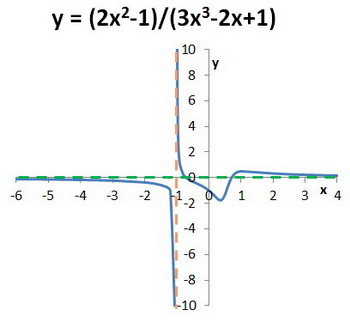How do you find the vertical, horizontal and slant asymptotes of #a(x)=(2x^2-1) / (3x^3-2x+1)#?
1 Answer
There is a vertical asymptote at
Explanation:
Step 1. Find the vertical asymptotes.
Set the denominator equal to zero and solve for
According to the rational root theorem, the rational roots of
So the only possible rational roots are
We have to test all four possibilities.
The only one that works is
So
There is a vertical asymptote at
Step 2. Find the horizontal asymptotes.
The degree of the numerator is lower than the degree of the denominator, so the
The horizontal asymptote is at
Step 3. Find the slant asymptotes.
A slant asymptote occurs when the degree of the numerator is higher than the degree of the denominator.
Here, the numerator is 2nd degree, and the denominator is 3rd degree, so there are no slant asymptotes.


